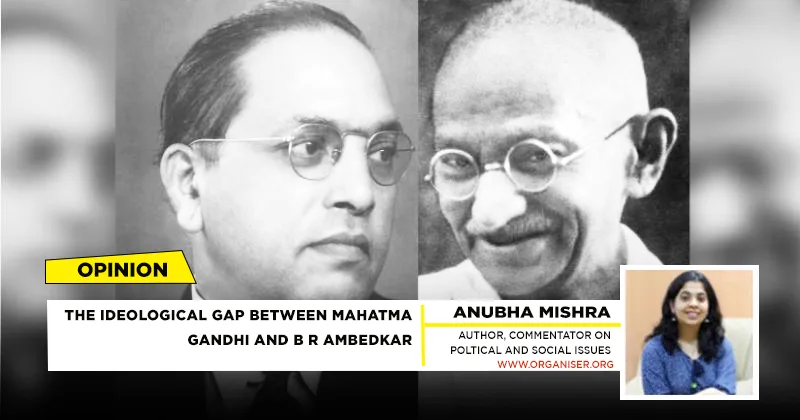April 14 marks the birth anniversary of Dr Bhim Rao Ambedkar, affectionately known as Babasaheb Ambedkar, revered by his followers as a champion of justice and equality. Each year, this occasion is commemorated not only by government officials and politicians but also by countless admirers both within India and around the world. Dr Ambedkar’s legacy is deeply intertwined with the Constitution of India, which he played a pivotal role in drafting to secure the rights of marginalised communities.
Gandhi and Ambedkar both played important roles in India’s fight for independence and worked towards social justice, they had differing philosophies and approaches. Gandhi believed in non-violent resistance and civil disobedience, while Ambedkar advocated for a more aggressive approach to achieving social equality. Additionally, Gandhi focused on maintaining the caste hierarchy, while Ambedkar focused on the rights of Dalits and uplifting the other marginalised groups within Indian society.

At Gandhi’s invitation, Ambedkar first met him on August 14, 1931 at Mani Bhavan in Maharashtra. But Gandhi gave him a cold shoulder response and did not acknowledge his presence for a while. After some time, the dialogue began with Gandhi’s response to Ambedkar’s grievances against him and Congress regarding the problems of untouchables.
He expressed his lack of faith in great leaders or Mahatma and was critical of Congress for its token recognition of untouchability and sincerity on the issue. Furthermore, Gandhi believed that taking action was necessary to achieve one’s goals. He promoted nonviolent forms of political protest, such as civil disobedience and non-cooperation.
He thought that these tactics could be effective in bringing about change. In contrast, Ambedkar believed that the Constitution could play a vital role in changing society by creating laws that would promote equality and fairness for all. Gandhi is touted as a crusader of bringing self-reliance to the villages as he advocated for their autonomy and self-sufficiency.
He thought that village autonomy would help ensure that all voices were heard equally and ultimately lead to the establishment of a harmonious traditional village community called Ram Raj. In contrast, Ambedkar criticised Gandhi’s ideas, claiming that they were the philosophy of the well-to-do and leisure class. He argued that local administration could lead to narrow-mindedness and communalism in villages and later could foster regionalism within states, and that autonomy could lead to bias and ultimately harm the freedom of others.
He preferred a top-down model of administration with a strong central government. The urge for justice and equality turned Ambedkar towards urbanisation, modernity, and industrialisation, while Gandhi was critical of the idea of modernity. Ambedkar was sceptical of Gandhi’s approach and the Congress’s sincerity in addressing untouchability.
He prioritised the self-respect and political empowerment of the Depressed Classes, and their ideological clash on untouchability ended without a resolution during the Second Round Table Conference in 1931. Notwithstanding Gandhi’s opposition, Dalit leaders continued to demand separate electorates for Dalits. Ambedkar went to London to lobby British cabinet members for it.
Eventually, British Prime Minister Ramsay MacDonald announced the Communal Award of 1932 (also known as the MacDonald Award), which provided separate electorates for Depressed Classes along with other minorities including Muslims. Gandhi, imprisoned in Yerawada Jail in Poona, responded by announcing an indefinite fast until the provision of separate electorates for untouchables was revoked. Ambedkar had to concede to Gandhi’s “extreme form of coercion” and sign the Poona Pact on September 24, 1932.
Madan Mohan Malviya signed on behalf of Gandhi. The pact replaced the separate electorate with reservations for the Depressed Classes. Following the pact, Gandhi broke his fast and proposed to establish the Anti-Untouchability League to continue the fight against untouchability.
However, tensions between Gandhi and Ambedkar persisted, reflecting their fundamentally different approaches to caste and social reform. The publication of Ambedkar’s Annihilation of Caste (1936) further angered Gandhi for its critique of caste-based discrimination. He responded by publishing two articles in his newspaper Harijan (11 and 18 July 1936) titled Dr Ambedkar’s Indictment.
Gandhi accused Ambedkar of wanting publicity. Gandhi went to the extent of calling Ambedkar a ‘challenge to Hinduism’. Despite Gandhi’s sharp criticism, Annihilation of Caste remains a seminal text, reflecting Ambedkar’s disappointment with the Poona Pact.
In the 1937 edition of Annihilation of Caste, Ambedkar included Gandhi’s responses and provided a detailed reply. He clarified that his motive was not to seek publicity but to provoke Hindus to think. Gandhi and Ambedkar had contrasting views on the political systems as well.
Gandhi was sceptical of parliamentary democracy and preferred a decentralised model of governance. He believed in the wisdom of the people and the need for a constitution suited to the Indian genius, free from external influences. Ambedkar supported a parliamentary system of government.
He saw it as a way to ensure representation and protect the rights of all citizens. Ambedkar believed in the importance of a strong constitutional framework to safeguard individual liberties and promote social justice. The standoff between Ambedkar and Gandhi continued on issues like conversion, village republic, and method of satyagraha.
Ambedkar likened the caste-ridden Hindu society to ‘a multi-storeyed tower with no staircase and no entrance’, symbolising its hierarchical system. Hence, he wanted to leave Hinduism and declared in Nasik in 1935 that he would not die a Hindu. In 1956, he converted to Buddhism.
The gap between the two had widened so much that in a 1955 BBC interview, Ambedkar said, “Gandhi was never a Mahatma; I refuse to call him a Mahatma.” Ambedkar also said that Gandhi was no reformer. “He was just an episode in the history of India, not an epoch maker,”.
The ideological gap between Mahatma Gandhi and B R Ambedkar

April 14 marks the birth anniversary of Dr Bhim Rao Ambedkar, affectionately known as Babasaheb Ambedkar, revered by his followers as a champion of justice and equality. Each year, this occasion is commemorated not only by government officials and politicians but also by countless admirers both within India and around the world. Dr Ambedkar’s legacy is deeply intertwined with the Constitution of India, which he played a pivotal role in drafting to secure the rights of marginalised communities. Gandhi and Ambedkar both played important roles in India’s fight for independence and worked towards social justice, they had differing philosophies and approaches. Gandhi believed in non-violent resistance and civil disobedience, while Ambedkar advocated for a more aggressive approach to achieving social equality. Additionally, Gandhi focused on maintaining the caste hierarchy, while Ambedkar focused on the rights of Dalits and uplifting the other marginalised groups within Indian society. At Gandhi’s invitation, Ambedkar first met him on August 14, 1931 at Mani Bhavan in Maharashtra. But Gandhi gave him a cold shoulder response and did not acknowledge his presence for a while. After some time, the dialogue began with Gandhi’s response to Ambedkar’s grievances against him and Congress regarding the problems of untouchables. He expressed his lack of faith in great leaders or Mahatma and was critical of Congress for its token recognition of untouchability and sincerity on the issue. Furthermore, Gandhi believed that taking action was necessary to achieve one’s goals. He promoted nonviolent forms of political protest, such as civil disobedience and non-cooperation. He thought that these tactics could be effective in bringing about change. In contrast, Ambedkar believed that the Constitution could play a vital role in changing society by creating laws that would promote equality and fairness for all. Gandhi is touted as a crusader of bringing self-reliance to the villages as he advocated for their autonomy and self-sufficiency. He thought that village autonomy would help ensure that all voices were heard equally and ultimately lead to the establishment of a harmonious traditional village community called Ram Raj. In contrast, Ambedkar criticised Gandhi’s ideas, claiming that they were the philosophy of the well-to-do and leisure class. He argued that local administration could lead to narrow-mindedness and communalism in villages and later could foster regionalism within states, and that autonomy could lead to bias and ultimately harm the freedom of others. He preferred a top-down model of administration with a strong central government. The urge for justice and equality turned Ambedkar towards urbanisation, modernity, and industrialisation, while Gandhi was critical of the idea of modernity. Ambedkar was sceptical of Gandhi’s approach and the Congress’s sincerity in addressing untouchability. He prioritised the self-respect and political empowerment of the Depressed Classes, and their ideological clash on untouchability ended without a resolution during the Second Round Table Conference in 1931. Notwithstanding Gandhi’s opposition, Dalit leaders continued to demand separate electorates for Dalits. Ambedkar went to London to lobby British cabinet members for it. Eventually, British Prime Minister Ramsay MacDonald announced the Communal Award of 1932 (also known as the MacDonald Award), which provided separate electorates for Depressed Classes along with other minorities including Muslims. Gandhi, imprisoned in Yerawada Jail in Poona, responded by announcing an indefinite fast until the provision of separate electorates for untouchables was revoked. Ambedkar had to concede to Gandhi’s “extreme form of coercion” and sign the Poona Pact on September 24, 1932. Madan Mohan Malviya signed on behalf of Gandhi. The pact replaced the separate electorate with reservations for the Depressed Classes. Following the pact, Gandhi broke his fast and proposed to establish the Anti-Untouchability League to continue the fight against untouchability. However, tensions between Gandhi and Ambedkar persisted, reflecting their fundamentally different approaches to caste and social reform. The publication of Ambedkar’s Annihilation of Caste (1936) further angered Gandhi for its critique of caste-based discrimination. He responded by publishing two articles in his newspaper Harijan (11 and 18 July 1936) titled Dr Ambedkar’s Indictment. Gandhi accused Ambedkar of wanting publicity. Gandhi went to the extent of calling Ambedkar a ‘challenge to Hinduism’. Despite Gandhi’s sharp criticism, Annihilation of Caste remains a seminal text, reflecting Ambedkar’s disappointment with the Poona Pact. In the 1937 edition of Annihilation of Caste, Ambedkar included Gandhi’s responses and provided a detailed reply. He clarified that his motive was not to seek publicity but to provoke Hindus to think. Gandhi and Ambedkar had contrasting views on the political systems as well. Gandhi was sceptical of parliamentary democracy and preferred a decentralised model of governance. He believed in the wisdom of the people and the need for a constitution suited to the Indian genius, free from external influences. Ambedkar supported a parliamentary system of government. He saw it as a way to ensure representation and protect the rights of all citizens. Ambedkar believed in the importance of a strong constitutional framework to safeguard individual liberties and promote social justice. The standoff between Ambedkar and Gandhi continued on issues like conversion, village republic, and method of satyagraha. Ambedkar likened the caste-ridden Hindu society to ‘a multi-storeyed tower with no staircase and no entrance’, symbolising its hierarchical system. Hence, he wanted to leave Hinduism and declared in Nasik in 1935 that he would not die a Hindu. In 1956, he converted to Buddhism. The gap between the two had widened so much that in a 1955 BBC interview, Ambedkar said, “Gandhi was never a Mahatma; I refuse to call him a Mahatma.” Ambedkar also said that Gandhi was no reformer. “He was just an episode in the history of India, not an epoch maker,”













